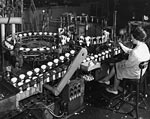






 |
|||||
 |
 |
 |
 |
 |
 |
|
Scottish Film Culture Before 1938
|
ProductionUp until the mid 1960s, the Committee's rate of production of documentaries was fairly low, averaging around three a year. In 1964 there was a rise to five documentaries a year, followed by a further sharp rise in 1970, peaking at ten documentaries produced in 1972 alone. Production is steady for the next few years but drops rapidly off to its pre-1965 figure at the end of the seventies. The Committee's press releases and reports divide the films into three groups: Tourist Films, Industrial Films, and Films of Various Aspects of National Life. Tourist films, or travelogues, make up 46% of the Committee's total output. They range in scope from covering a single town in a film such as Dunfermline (1974), or a single island in films like The Isle of Rhum (1970), to covering a collection of islands such as the Hebrides in Enchanted Isles (1957), an entire region in a film such as Perthshire Panorama (1959), or, more rarely, the whole country in films like Busman's Holiday (1959). The travelogues are discussed in more detail in 'The Travelogue' section. Industrial films, which include films on public services, make up 28% of the Committee's production. An article distributed by the Committee (1959) entitled 'Films for Industry' stated that: |
 County of the Clyde (1963) made by Anglo Scottish Pictures for Lanarkshire Industrial Development Centre. |
"One of the principal aims in setting up the Committee was to provide a service to industrialists who have a story of achievement to tell or have goods to sell in the world market. In comparison with the rest of Britain, the number of films made in Scotland on industrial themes is so small as to produce an imbalance in the projection of British industrial effort [...] An opportunity is being lost by industry in Scotland. It is being lost because Scottish industrialists are not making adequate use of the knowledgeable and experienced body available to assist them in employing the film to the best advantage. The Committee offers an assurance that a project will be carefully supervised from the conception of the basic idea through all the stages of production to the completion of the film." |
|
|
The Committee's Industrial Films, a category which also covers films on social planning and welfare, includes documentaries such as The Big Mill (1963), an account of the steel mills at Gartcosh and Ravenscraig; The Hollow Mountain (1966), a description of the engineering work involved in building the hydro-electric scheme at Ben Cruachan; If Only we had the Space (1974), an account of the modernisation of some of Glasgow's tenements; and Water, Water, Everywhere (1967), a look at Scotland's water surplus in relation to the rest of the world's water shortage problems. As even this small sample indicates, this part of the Committee's production activities have much in common with the work of the GPO film unit in the 1930s and films such as Industrial Britain (1931), Housing Problems (1935), Coalface (1935), and Night Mail (1936). Films on Various Aspects of National Life make up 15% of the Committee's production. This category receives little comment in the Committee's various public papers, as a certain nervousness surrounds the subject of national imagery. Speaking at a press screening of From Glasgow Green to Bendigo (1958), a documentary on carpet manufacturing in Glasgow, Sir Alexander King (1958, November 27), echoing Grierson's words in 1938, commented: "I have nothing against the kilt, the caber, or the bag-pipe. In their own way they are all admirable [...] but as symbols of a country in a workaday world they are not enough', although he admitted that 'as a Committee we have made several films which pay their tribute to these national symbols" (p. 1). Similarly at a News Conference four years later Sir Alexander (1962, November 21) repeated this anxiety: "When the Committee was set up by the Secretary of State he asked us to project Scotland on the screens of the world. He was anxious that a balanced and authentic picture of Scotland should by in circulation to offset the caricature which is so often passed off for our country" (p. 1). |
|
|
In place of the invented traditions of national pastimes and national costume the documentaries in this section, with the exception of a film like Scotland Dances (1957), are primarily biographies of Scottish artists, writers, designers, photographers, musicians, and architects. The films in this section include The Hand of Adam (1975) a tour of the architectural works of Robert Adam; Hugh MacDiarmid: No Fellow Travellers (1972), a conversation between the poet, his son, and Norman MacCaig, and a discussion of his work by other poets in Edinburgh's Milne's bar; and The Sun Pictures (1965), an account of mid-nineteenth century photographers David Hill and Robert Adamson. The remaining miscellaneous documentaries include a number of wildlife films and the Committee's only feature film, The Duna Bull (1973). |


|
|
| Author: Richard Butt | Images are drawn from the SCRAN database. |